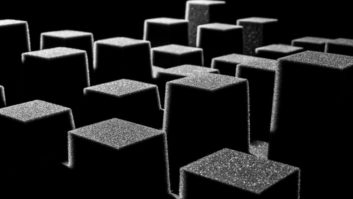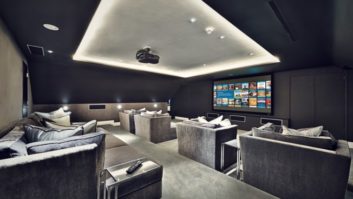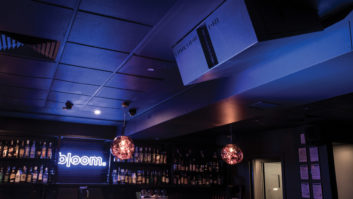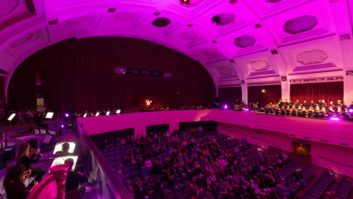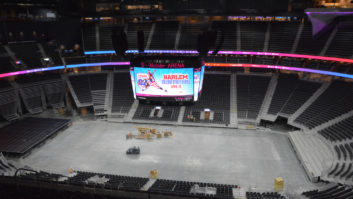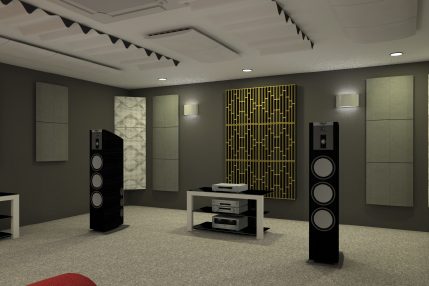
Columnist Rob Lane reveals why acoustics are more important than ever.
As anyone with a modest grasp of acoustics will tell you, the purest venue for a one-on-one conversation is outside. In the correct conditions, there is zero reverberation time (RT) outside, which means that when someone speaks, the sound immediately dissipates, allowing the next word to be heard without being ‘infected’ by reverberation from the first. Sure, other factors outside can introduce additional problems – wind, birdsong, road works – but in the purest sense, outside is where it’s at, acoustically.
So, how does RT affect and infect the inside of buildings – where the majority of us do our talking and? Of course, it depends upon a number of factors, including ceiling height, size and shape of room, substance of the room’s walls, furnishings and so on, but the smaller the room, the trickier the acoustics. This is because most research has focused on large auditoriums or small recording studios – not videoconferencing or hi-fi demo rooms.
UC and acoustics
With unified communications such a huge part of AV these days, one might assume that acoustics would be at the forefront of any decisions regarding technology. Unfortunately, architects and interior designers often have other priorities: when you consider that AV has, for many years, been a secondary consideration, it’s not really surprising that acoustic design treatments take second or even third place also!
Working environments are often packed with highly reflective materials like glass and metal; add tables and AV kit, and acoustics in a boardroom can be very problematic indeed. Add to that the fact that interior designers are generally not fans of acoustic treatment kit – such as baffles and diffusers, more generally seen in recording studios and hi-fi demo rooms (try not to visualise egg boxes!) – and it’s easy to see why RT is such an issue in today’s UC-heavy workspaces.
“Acoustics should be a major priority for anyone building a collaboration space, but it’s fair to say though that it is often neglected by some,” Wayne Mason, EMEA UCC general manager & practice lead at Westcon, told me. “Our pre-sales consultants are always thinking about RT and how a room might be affected by glass tables and hard walls. They always ensure that dampening is specified and that the human voice is optimised.”
Although Westcon doesn’t sell acoustic treatment equipment, the company always brings in acoustics specialists and is set to ramp up its pro audio requirements and specialisation. With the demand for UC continuing to grow, as more and more facilities managers are tasked with creating tech-heavy boardrooms and huddle spaces, it’s clear that other UC specialists need to also place more importance in acoustic treatments.
Even better listening
In the consumer AV world, one hi-fi outlet that understands the true value of acoustics is the highly respected KJ West One, in London’s Marylebone. Renowned for its approach to selling hi-fi components and systems (based on client relationships), it boasts one of the best listening rooms in the UK – and it’s set to get even better.
KJ has been in discussions with Artnovian, which ‘pushes the boundaries of acoustic engineering’ with an array of attractive acoustics treatment products. Artnovian has proposed a series of treatments that would make a stunning-sounding demo room even more stunning.
The proposal includes attractive bass absorption panels in the corners of the room, sound diffusers/absorbers on the walls, and further diffusion designs above to maintain the ‘energy’ of the room by ‘acoustically raising’ the ceiling.
“The sound diffusers/absorbers will help with the central imaging, taking care of the first reflection point but not destroying the life of the sound –not a full-range broadband absorber, in other words,” Chris Adair, CEO of KJ Cinemas, a division of KJ West One, told me. “In the ceiling there is diffusion to maintain the energy in the room – very important with domestic hi-fi in particular; you don’t want the room to sound dead.”
Even if it were realistic to install a boardroom or a home cinema in the acoustic-friendly outdoors, the challenges to audio engineers would be myriad. In the acoustic-unfriendly indoors those challenges multiply, ironically as more technology and technology-facilitating hardware is specified. If acoustic design isn’t front and centre, across all pro or consumer AV projects, it’s pretty clear – loud and clear in fact – that it should be.
